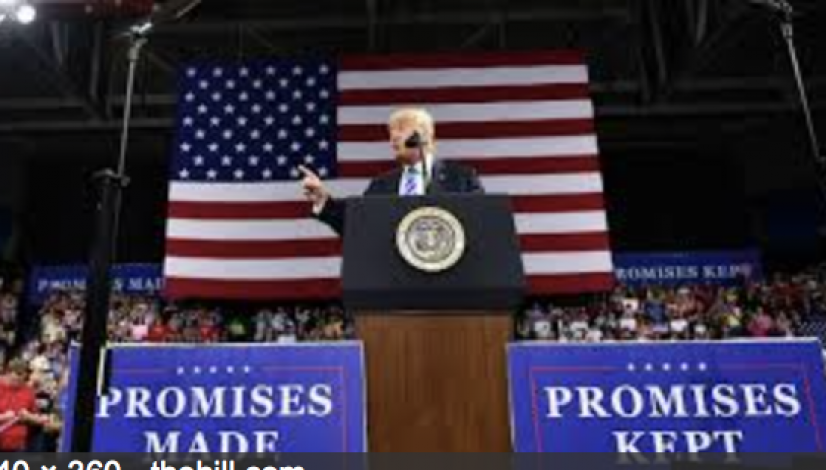Trump is winning trade wars and honoring campaign promises

The establishment is in for another shock: President Trump’s administration may soon win significant breakthroughs in our trade agreements.
The North American Free Trade Agreement (NAFTA) rewrite with Mexico looks close to completion, and Canada cannot be far behind. The Chinese have blinked, apparently alarmed by a slowing economy. At the same time, the U.S. and the EU are seeking common ground on lowering trade barriers. Win, win, win.
Resolving new trade pacts with any of these partners — much less all three — would be welcomed by investors and would also be an astonishing feat, not least because tweaking such agreements normally takes years to complete.
For instance, negotiations that led to a trade deal with South Korea, signed by President Obama in 2011, began during the George W. Bush administration.
Using both sticks and carrots, the White House has pressed trade partners over what the president has called some of the worst deals of all time.
Promising to level the playing field for our companies was one of President Trump’s central campaign promises in 2016, and it won over many of the blue-collar workers who traditionally vote Democratic.
From the looks of it, he is following through on that promise. For sure, the negotiations with China could still blow up, but so too could those with the our EU and NAFTA partners.
But here’s what Trump got right: These trading partners need us more than we need them. That allows him to play hardball, and he has done just that.
Earlier this week, Reuters reported important progress in the rewrite of our trade agreement with Mexico. This isn’t just a matter of refreshing an outdated 24-year-old contract that fails, for instance, to cover internet-age industries.
The president’s team has insisted on some concrete improvements in the deal, such as:
- raising the wages paid to Mexico’s workers on roughly 40 percent of a car’s value to around $16 per hour, compared to average manufacturing wages of under $3;
- stiffening local content rules determining whether automobiles qualify for zero import tariffs; and
- demanding that more steel and aluminum used in autos be sourced from North America.
It appears the final sticking point is a U.S. demand for a sunset clause, which would allow the countries to exit the agreement after five years.
This must be a bargaining tool; it’s hard to imagine the White House unwilling to stretch the time frame, or even refusing to budge on this issue. After all, Trump is a real estate developer; he knows how important certainty is to planning long-term projects.
Canada has not been included in the recent talks with Mexico, which have focused primarily on issues specific to our southern neighbor.
In addition, Canada appears to be pouting, responding to a tiff between Trump and Prime Minister Justin Trudeau and a consequent souring of Canadians’ view of the U.S. But exports accounted for 30 percent of Canada’s GDP last year, and 75 percent of their goods shipments went to the U.S.
Trudeau has just announced he will run for re-election in October 2019. Even though his confrontation with President Trump lifted his personal popularity, his party has lost ground among voters. He will not want his campaign hampered by a stuttering economy.
Trudeau will need to cede some ground to assure exports continue strong. That could mean reducing its extremely high dairy tariffs.
Meanwhile, Chinese and U.S. trade maestros are talking again, though both sides followed through Thursday with the implementation of 25-percent tariffs on $16 billion worth of each other’s goods.
China’s economy appears to be slowing. Retail spending was up 8.8 percent year-over-year in July, short of expectations and below the 2010-2018 average growth rate of 12.39 percent. Moreover, China’s manufacturing PMI, while still signaling expansion, dropped in July to a 5-month low.
In response, officials have reversed course on plans to build consumer spending and rein in unwieldy debt, resorting to past practices of boosting infrastructure spending to pump up growth.
President Xi, like Trump, wants to save face and appear victorious in this trade war. Though he will never face re-election, his grip on power could be shaken by criticism of his management, which is rising. Beijing’s $300 billion-plus trade surplus with the U.S. allows for plenty of concessions.
Finally, the surprise announcement late last month by President Trump and European Commission President Jean-Claude Juncker that the U.S. and EU would work toward lower tariffs signaled a welcome effort to avert a spreading trade feud.
Recent estimates that Germany will report the world’s largest trade surplus for the third year in a row, roughly $300 billion, or 7.8 percent of its GDP, puts pressure on Berlin to negotiate in good faith.
Critics, including the International Monetary Fund (IMF), have called out Germany for keeping worker pay low and for taking advantage of a weak euro. Any effort to rebalance the economy should allow for higher imports from the U.S.
Commerce Secretary Wilbur Ross is delaying his review of possible tariffs on imported cars, previously scheduled to have been completed this month. We can take that as an olive branch to the EU and to our NAFTA partners, signaling progress.
The timing of all these ventures is uncertain. But getting even one or two agreements resolved would go a long way toward vindicating President Trump’s aggressive posture on trade, as well as reassuring political allies in industry and the farm belt.
To his credit, Trump is working toward one of his campaign’s central promises: trade that is free, but also fair to U.S. workers. It’s a wonder that hasn’t been a higher priority all along.
Published on The Hill




